
Flower-rich foraging habitat for native bees
Native pollinators have
three main requirements --- flowers, nesting sites, and overwintering
habitat. We'll cover the other two in later posts, but for now I
want to talk about flowers for wild bees.
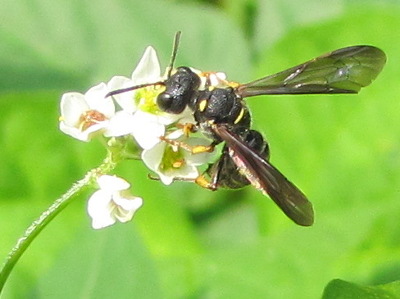
Attracting
Native Pollinators
takes a holistic approach to providing forage for wild
pollinators. Rather than listing a few key plants, they recommend
that you create open, sunny patches of flowers that bloom throughout
the entire growing season. The best patches are big and round ---
at least three feet in diameter of the same flower species --- but
linear corridors along fences or roads can also be effective.
When planning pollinator patches, try to think like a tiny bee,
remembering that the smallest pollinators may only fly 600 feet or less
each day in search of food. If you have flowerbeds already
scattered around your homestead, can you join them together with
corridors or stepping stones (small patches of flowers) to make it
easier for the bees to move from point A to point B?
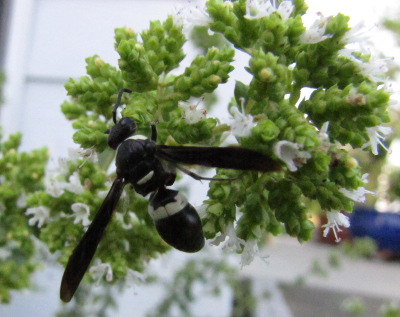 Next, consider the types of
plants in your forage areas. Head out into your garden in the
summer and take note of which plants are already drawing in pollinators
--- for us, some of the wild bees' favorite attractions are our
overgrown oregano bed, our peach trees, and our buckwheat
cover crops.
Are there times of the year when very few or no flowers are in
bloom? If so, you'll want to hunt down pollinator-friendly
flowers to fill in those gaps.
Next, consider the types of
plants in your forage areas. Head out into your garden in the
summer and take note of which plants are already drawing in pollinators
--- for us, some of the wild bees' favorite attractions are our
overgrown oregano bed, our peach trees, and our buckwheat
cover crops.
Are there times of the year when very few or no flowers are in
bloom? If so, you'll want to hunt down pollinator-friendly
flowers to fill in those gaps.
When choosing plants,
consider native plants, or at least cultivated varieties that haven't
been bred to be excessively showy --- the most ornamental flowers have
usually developed double petals and other fancy features at the expense
of the pollen and nectar 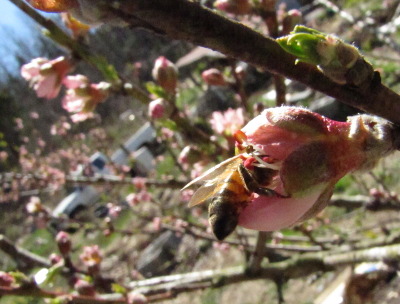 that bees depend on.
Aim for at least nine plant species in your forage areas --- three each
for spring, summer, and fall --- and try to include at least one plant
that blooms very early in spring and one that blooms very late in the
fall.
that bees depend on.
Aim for at least nine plant species in your forage areas --- three each
for spring, summer, and fall --- and try to include at least one plant
that blooms very early in spring and one that blooms very late in the
fall.
Finally, the Xerces
Society recommends that you include at least one native warm-season
bunch grass or sedge in wildflower meadows, planning for the grass to
cover 30% or less of the ground area. Native bunch grasses host
butterflies, provide nest sites for bumblebees and overwintering sites
for other insects, and make the landscape more weed-resistant.
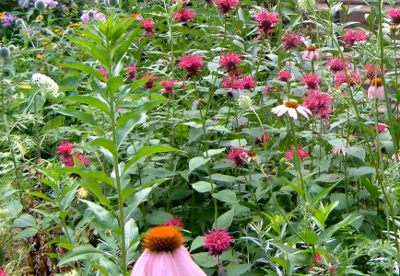 How do you maintain a
pollinator meadow? Depending on the scale of your project, you
may choose grazing, mowing, or fire, but be sure to do so patchily and
at low intensity. For example, if you're going to mow your meadow
to keep tree seedlings and weeds at bay, cut the plants at 12 to 16
inches and mow slowly in daylight, using a flushing bar to encourage
animals to move out of the way. Mow or burn no more than a third
or a quarter of the area at a time so that animals can escape to nearby
untouched areas. If you graze, do so at low intensity and rotate
animals out quickly; if you burn, leave areas fire-free for 5 to 10
years.
How do you maintain a
pollinator meadow? Depending on the scale of your project, you
may choose grazing, mowing, or fire, but be sure to do so patchily and
at low intensity. For example, if you're going to mow your meadow
to keep tree seedlings and weeds at bay, cut the plants at 12 to 16
inches and mow slowly in daylight, using a flushing bar to encourage
animals to move out of the way. Mow or burn no more than a third
or a quarter of the area at a time so that animals can escape to nearby
untouched areas. If you graze, do so at low intensity and rotate
animals out quickly; if you burn, leave areas fire-free for 5 to 10
years.
Sounds pretty daunting,
huh? I've gotten bogged down in creating pollinator habitat in
the past because I simply can't talk myself into managing flowers in
the summer when the vegetable garden demands so much of my time.
As a result, I'm pondering a few different options:
- Focusing on perennial flowers --- Annual flower beds clearly aren't my cup of tea, but my perennial flowers survive neglect as long as they get weeded and mulched once a year. Clearly I need to think further in that direction.
- Combining flowers with pastures --- I'm tempted to turn one of our chicken pastures into a pollinator meadow. The management techniques used to attract pollinators are just the opposite of what I'd do to promote maximum food for chickens, but surely there's a way to meet in the middle?
- Flowers in the forest garden
--- The flowers in my forest gardens tend to fall by the wayside since
they're annuals and I ignore them. But if I grew perennials
around each of my fruit trees, I'd have good pollinator habitat close
to most of my garden areas.
Do you have low-work
pollinator forage areas? What are your key management techniques
to keep them going?
| This post is part of our Attracting Native Pollinators lunchtime
series.
Read all of the entries: |
Want more in-depth information? Browse through our books.
Or explore more posts by date or by subject.
About us: Anna Hess and Mark Hamilton spent over a decade living self-sufficiently in the mountains of Virginia before moving north to start over from scratch in the foothills of Ohio. They've experimented with permaculture, no-till gardening, trailersteading, home-based microbusinesses and much more, writing about their adventures in both blogs and books.
Want to be notified when new comments are posted on this page? Click on the RSS button after you add a comment to subscribe to the comment feed, or simply check the box beside "email replies to me" while writing your comment.
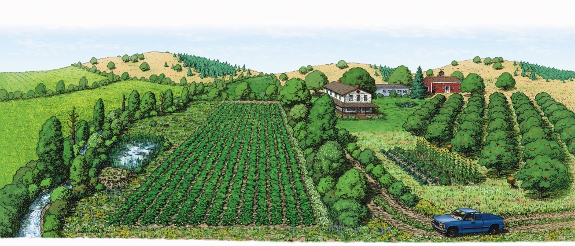

This is great! Especially the details about the shapes of wildflower patches. I'd not run into that yet. Some buddies and I are planning a permaculture orchard for this spring, so we've been looking at the natives and pollinator attractor plants pretty intensely. All the research I'm finding absolutely agrees with your 'full season flowering' comment too. The single key factor for resiliency in various test plots (Colorado and Maryland) has been complexity. The more complex / more diverse the site, the fewer the pest issues across the board. ~Molly